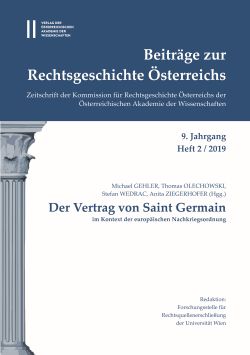
Beiträge zur Rechtsgeschichte Österreichs 9. Jahrgang Heft 2/2019, pp. 320-331, 2019/12/01
Der Vertrag von Saint Germain
im Kontext der europäischen Nachkriegsordnung
British policy concerning the Treaty of St Germain devolved from Prime Minister David Lloyd George. In developingwar aims during the Great War, the British looked to maintain Austria-Hungary as a post-war Great Power, admittedlydiminished, to balance between Germany and Russia. This goal evaporated by October 1918 as the HabsburgMonarchy collapsed and successor states arose in Central-Eastern Europe. The Allies handled Germany’s settlement,the Treaty of Versailles, first at the Paris Peace Conference. Its three-part focus – territorial adjustments, reparations,and disarmament – provided the model for British policy towards Austria. A key to Lloyd George’s ideas – his pragmatismobviated clear strategy – was to avoid future British military commitments for European security. ArthurBalfour, the foreign secretary, and Eyre Crowe, a Foreign Office mandarin, received responsibility for negotiating St.Germain; they played a major role in giving new Austria sensible borders and reasonable security. Doing so, however,they followed Lloyd George’s dictates about military commitments. The British subsequently used effective economicdiplomacy to assist Austria’s financial reconstruction that allowed influence over its shape and democratic – that iscapitalist – structure.
Keywords: 1914–1920 – Austria – Arthur BALFOUR – Eyre CROWE – Great Britain Foreign Policy – David LLOYD GEORGE – Treaty of St. Germain – Treaty of Versailles